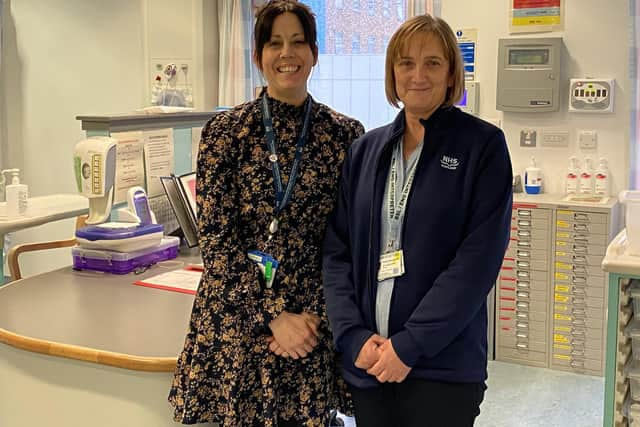NHS Fife's first dedicated British Sign Language interpreter helping improve patient experience
and live on Freeview channel 276
An elderly deaf patient named “James” had been at Kirkcaldy’s Victoria Hospital for weeks without being able to effectively communicate with anyone.
However, that all changed in early January when NHS Fife’s first British Sign Language (BSL) translator came on board.
Advertisement
Hide AdAdvertisement
Hide AdMandy McCreadie joined NHS Fife as the first dedicated BSL translator on January 8. That same day she met “James” – an elderly deaf man who had been in hospital since December 14.


James’ only form of communication was BSL and a bit of written English. For weeks, he had been unable to communicate fluently with his doctors and nurses.
Doctors were planning to send him home until Ms McCreadie spoke to James and discovered he had serious concerns about returning home and getting up and down his stairs.
“Turned out he had literally been crawling up and down the stairs. So the decision was made that he would be transferred to the Queen Margaret in Dunfermline,” she said.
Advertisement
Hide AdAdvertisement
Hide AdMs McCreadie was able to help both James and hospital staff through the transfer.
“It made a huge difference to the experience James had in hospital. For him it took away the extra stress he had, worrying about communication. Worrying that his views, opinions and needs were being fully expressed and listened to,” she said.
James passed away shortly after his hospital transfer, but Ms McCreadie said being able to fluently communicate made a big difference in James’ final days.
“We went through menus and he was able to choose his meals. We were able to facilitate conversation between him and the patient in the next bed about football. It was very important to James and it made a massive difference to his day,” she said.
Advertisement
Hide AdAdvertisement
Hide Ad“Sadly he passed away shortly after transfer, but the meal he had before he passed was the first meal he chose himself. I’m pleased we were able to offer that for him and give him a much more positive experience in his last couple of weeks.”
She added: “We absolutely need to continue to give that level of care to future patients who use BSL and stay in hospital for a number of weeks.”
James’ story in particular was highlighted to the NHS Fife Board this week as an example of how Ms McCreadie’s new role is helping patients.
However, she has also helped many more BSL patients in Fife. In her first few weeks, Ms McCreadie has already covered a total of 46 appointments across the Kingdom.
Advertisement
Hide AdAdvertisement
Hide Ad“Although I have been in the role for a short period of time, it has already been really rewarding to have been able to work with and get to know Deaf BSL users coming into hospital,” she said.
“My hope is that we can develop the service further over the coming months as we try and make the experience of BSL users attending hospital that little bit easier.”
The dedicated BSL role is part of an initial six-month pilot, with hopes of extending the project further if it is successful.
“We are delighted to welcome Mandy as our first dedicated BSL interpreter,” Director of Nursing, Janette Keenan, said.
Advertisement
Hide AdAdvertisement
Hide Ad“Although the use of BSL interpreters in the NHS is not new, having a dedicated member of staff on-site will allow us to be much more responsive to the needs of Deaf BSL-using patients.
She continued: “I’m convinced that Mandy’s appointment will be really beneficial to BSL users accessing our services, and will not only help ensure that the communication between healthcare staff and patients is as smooth as possible, but that the wants and needs of patients are taken on board and understood.”